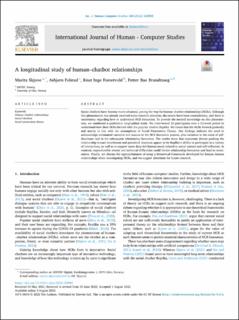| dc.contributor.author | Skjuve, Marita | |
| dc.contributor.author | Følstad, Asbjørn | |
| dc.contributor.author | Fostervold, Knut Inge | |
| dc.contributor.author | Brandtzæg, Petter Bae | |
| dc.date.accessioned | 2022-10-20T13:14:22Z | |
| dc.date.available | 2022-10-20T13:14:22Z | |
| dc.date.created | 2022-09-03T15:04:20Z | |
| dc.date.issued | 2022 | |
| dc.identifier.citation | International Journal of Human-Computer Studies. 2022, 168, 102903. | en_US |
| dc.identifier.issn | 1071-5819 | |
| dc.identifier.uri | https://hdl.handle.net/11250/3027349 | |
| dc.description.abstract | Social chatbots have become more advanced, paving the way for human–chatbot relationships (HCRs). Although this phenomenon has already received some research attention, the results have been contradictory, and there is uncertainty regarding how to understand HCR formation. To provide the needed knowledge on this phenomenon, we conducted a qualitative longitudinal study. We interviewed 25 participants over a 12-week period to understand how their HCRs formed with the popular chatbot Replika. We found that the HCRs formed gradually and mostly in line with the assumptions of Social Penetration Theory. Our findings indicate the need to acknowledge substantial variation and nuance in the HCR formation process, plus variation in the onset of self-disclosure and in the subsequent relationship formation. The results show that important drivers pushing the relationship toward attachment and perceived closeness appear to be Replika's ability to participate in a variety of interactions, as well as to support more deep-felt human needs related to social contact and self-reflection. In contrast, unpredictable events and technical difficulties could hinder relationship formation and lead to termination. Finally, we discuss the appropriateness of using a theoretical framework developed for human–human relationships when investigating HCRs, and we suggest directions for future research. | en_US |
| dc.language.iso | eng | en_US |
| dc.publisher | Elsevier | en_US |
| dc.rights | Navngivelse 4.0 Internasjonal | * |
| dc.rights.uri | http://creativecommons.org/licenses/by/4.0/deed.no | * |
| dc.subject | Human–chatbot relationships | en_US |
| dc.subject | Social chatbots | en_US |
| dc.subject | Social penetration theory | en_US |
| dc.title | A longitudinal study of human–chatbot relationships | en_US |
| dc.title.alternative | A longitudinal study of human–chatbot relationships | en_US |
| dc.type | Peer reviewed | en_US |
| dc.type | Journal article | en_US |
| dc.description.version | publishedVersion | en_US |
| dc.rights.holder | © 2022 The Authors | en_US |
| dc.source.volume | 168 | en_US |
| dc.source.journal | International Journal of Human-Computer Studies | en_US |
| dc.identifier.doi | 10.1016/j.ijhcs.2022.102903 | |
| dc.identifier.cristin | 2048581 | |
| dc.relation.project | Norges forskningsråd: 262848 | en_US |
| dc.relation.project | Norges forskningsråd: 270940 | en_US |
| dc.source.articlenumber | 102903 | en_US |
| cristin.ispublished | true | |
| cristin.fulltext | original | |
| cristin.qualitycode | 1 | |

